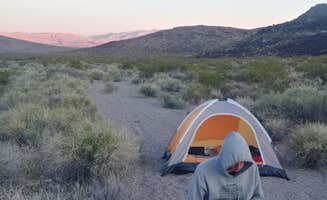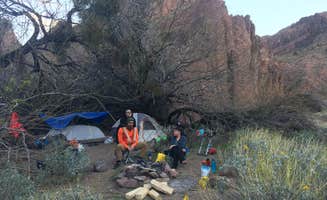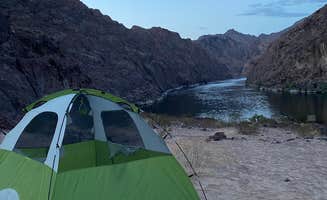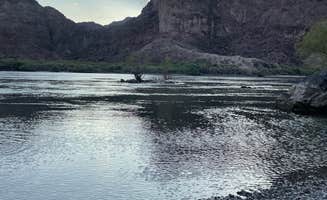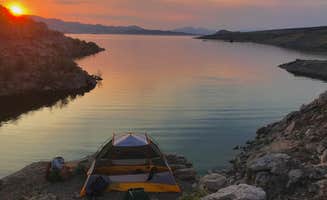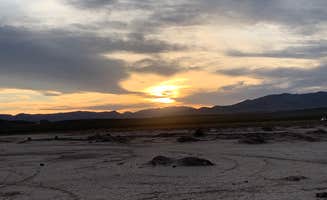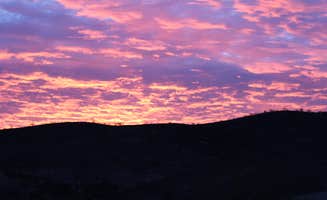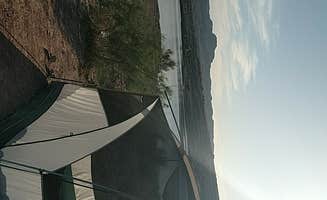The Boulder City region features several dispersed camping areas located within Lake Mead National Recreation Area and surrounding Bureau of Land Management lands. These sites offer primitive camping near Boulder City, Nevada without developed facilities. The area maintains year-round accessibility thanks to its desert climate with temperatures ranging 70-110°F in summer and 40-65°F in winter. Most free camping locations require visitors to be self-sufficient with water and waste management supplies.
What to do
Stargazing by the lake: At Kingman Wash, clear desert nights provide excellent viewing conditions. "We had great views and good cross country hiking. No ammenities. You are boondocking here," notes Leah W. about Government Wash, which offers similar dark sky conditions.
Hot spring exploration: Arizona Hot Spring provides natural hot pools after a moderate hike. "The spring discharges highly mineralized water at a rate of about 30 gallons per minute and a temperature of about 111 degrees Fahrenheit," explains Emmanuel L. from Arizona Hot Springs.
Off-road adventures: The Jean/Roach Dry Lakes area supports various off-road activities. "Dirt bike riding is a must out here. From dry flat lake bed, to bumps and jumps, to trails to the mountains- there is all kinds of terrain especially for starters," says Shalynn S. about Dispersed-jean/roach Dry Lakes.
What campers like
Wildlife encounters: Kingman Wash offers unexpected animal sightings. "We had two [burros] that visited us (please don't feed them!) and were a delightful change of wildlife from the bears and deer we are used to back home. You could hear them 'talking' near the water later that eve," reports Amy G. from Kingman Wash.
Paddleboarding opportunities: Lake access points provide water recreation spots. "The water is great and is perfect for my paddleboard! Weather wise be prepared for the heat. It was 101°F when we arrived, 80° at night. Bring lots of water to drink!" advises Peaches E. about Kingman Wash.
Secluded camping spots: Black Canyon offers riverside privacy. "We outfitted our travel trailer with solar so we can RR at dispersed sites like this (free roam camping)," explains Jason M. about Government Wash. Similar options exist at Black Canyon of the Colorado where "you will find numerous backcountry camping options on both the AZ and NV sides, many with existing fire rings."
What you should know
Road conditions vary dramatically: Many access roads require careful driving. "This campsite, based on view, seclusion and amazing-ness in general gets 5 stars for sure. Getting there is something you really have to want to do. The road is about 3 miles, but takes about 25 minutes to traverse. It's hilly, bumpy and holey," explains Amy G. about Kingman Wash.
Limited facilities at most sites: Free camping areas typically have minimal services. "I didn't have high expectations coming here. Just needed a spot to pull off for the night, and that is what this review is based off of. Nice paved road in, had no problem with finding a spot for a 38' Class A," notes Trinity M.
Water level fluctuations impact access: Drought conditions affect shoreline camping. "Rough road in but larger rigs can make it without getting stuck if carful. Only issue is with the water so low the level stuff is way back," reports Mike M. about Kingman Wash.
Tips for camping with families
Bring entertainment for children: The isolated nature of these sites requires planning. "We spent hours in the springs with other hikers until well into the evening hours. The glow of candles provided by one hiker created an ambiance and after the glow faded the darkest most star filled night skies could be seen," shares Crystal C. about Arizona Hot Springs.
Consider beach camping for easy water access: Riverside locations offer natural play areas. "We kayak in to set up camp for the night. There is a rustic toilet you can use, no water available other than the river. Our camp site was away from the masses, we took our camping gear further away from the crowded main camping area," recommends Cresta P.
Pack abundant drinking water: The desert environment demands proper hydration. "Pack plenty of water!! There are NO places to collect potable water so you will want to make sure to have enough for the hike in and out as well as the night," warns Crystal C.
Tips from RVers
Solar setups extend stays: Self-contained power systems benefit boondocking RVers. "We are in a short skoolie and so clearance was not an issue - we stayed out of the sandier areas at the beach and did fine. It is a tricky road but slow is the key," advises Jenni I. from Eight Mile Dispersed Camping.
Prepare for dusty conditions: Sand and dust management is essential. "When you are inside Lake Mead you are able to use the dump station and freshwater to fill up your tanks at Boulder Beach campground. We love coming here because it is not usually busy and we like our own quiet space," shares Michael B. about Eight Mile Dispersed Camping.
Avoid busy weekends when possible: Crowds impact site availability. "This place is very busy during the summer months and people stay for quite a while so remember that... But it's free camping and that's always a bonus. It's dispersed with no amenities. If you can get to the waterfront of this place it's awesome!" notes Brittney C.


